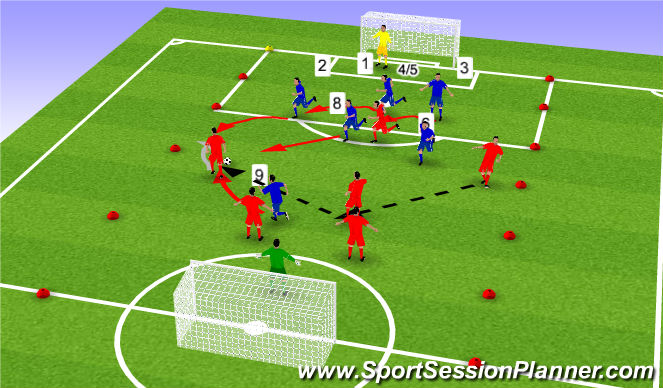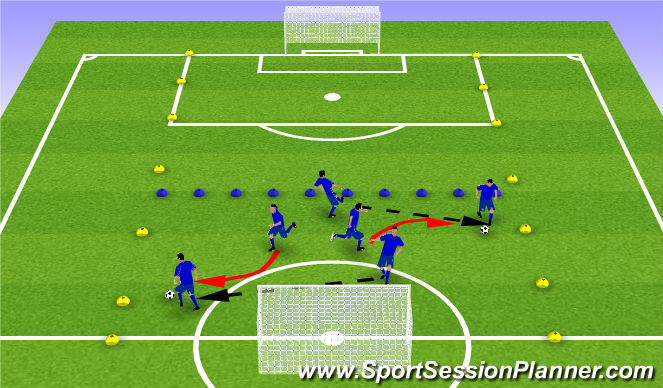Football/Soccer Session (Moderate): U14: Improving the team's ability to defend against wide attacking play (Defensive Principles) (Start Time: 2017-01-29 11:00:00)

Profile Summary

| Name: | Robert Capewell |
|---|---|
| City: | Gonzales |
| Country: | United States of America |
| Membership: | Adult Member |
| Sport: | Football/Soccer |
Description
Who - #1, #3, #4, #5, #2, #7, #11, #6, #8, #10 & #9
What - Improving the team's ability to defend against wide attacking play (Stopping the opposite team from attacking down the wide areas)
Why - Playing a 1-4-3-3 formation means that our strongest area of the field is central. We want the oppsition to stay central so that we can win the ball with more numbers. However, if the opposition do manage to get into wide areas, we need to be able, as a team, to shift wide to create a numerical advtantage so su
Where - Right and left flank
When - When we do not have possession of the ball and the opposition have moved the ball into the left or right flank.
How - #3 & #2 must read the game so that they can arrive at their opposing wide player early. By curving their run, the defensive player needs to decide if they have enough support from the #6, #8 #10 to show them inside or to force the opponent into a 1v1 down the line.
- #6, #8 & #10 must slow the switch of play down from the opposition. If the oppositions switches the play quickly, they have a full half of the field to attack down.
- #7 & #11 need to recognise what angle to approach as a defender when they come from behind the ball.
- All players must recognise to press the space of an opposing player when they enter the middle of the field.

See the guidance at the top of this page to understand why you are not seeing interactive Football/Soccer images.

SSG - Applying the 1st and 2nd defender principles and introduction of 3rd defender (10 mins)
SSG - Applying the 1st and 2nd defender principles and introduction of 3rd defender
Blue Team = Defending team (Focus is to defend the wide areas by shifting across accordingly. But, the blue team must recognise how to use their shape if the ball is wide or if the ball is central, based upon how the opposition are spread out.
Red Team = Attacking team (Focussing on stretching the opposition wide. If the opportunity occurs and the blue team have no pressured you, go for the shot, the blue team must be aware of this) Red team will always score their points from scoring a goal.
1st Rep - Blue team earn 1 point every time they steal the ball and make 1 successful pass. The game restarts from a red player passing the ball in from the side.
2nd Rep - Blue team will earn 1 point if they can score through the either of the 2 goals in each corner of their playing area. The game restarts from a red player passing the ball in from the side.
3rd Rep - Blue team will earn 1 point if they can dribble through either of the 2 goals. The game restarts from a red player passing the ball in from the side.
Red Team to play as if they would attacking the penalty area of the blue team. They get 1 point for every goal they score. Blue team must defend their own goal and score a point every time that they disposses the ball from the opposition and secure 1 successful pass. The game then restarts with a red player passing a ball in from the side. The red players are allowed their first pass to be free.
Coaching Points
- #4 & #5 must see the trigger of their #2 or #3 to send them to move across in support to the #2 or #3's rear.
- #3 & #2 must read the game so that they can arrive at their opposing wide player early. By curving their run, the defensive player needs to decide if they have arrived to late and are force to the opponent down the line or if they have arrived early enough to force the opponent away from the goal.

See the guidance at the top of this page to understand why you are not seeing interactive Football/Soccer images.

ESSG - Application of 1st, 2nd & 3rd defensive principles (15 mins)
ESSG - Application of 1st, 2nd & 3rd defensive principles within full game rules
Coaching Points
- #3 & #2 must read the game so that they can arrive at their opposing wide player early. By curving their run, the defensive player needs to decide if they have enough support from the #6, #8 #10 to show them inside or to force the opponent into a 1v1 down the line.
- #4 & #5 must see the trigger of their #2 or #3 to send them to move across in support to the #2 or #3's rear.
- #6 will fill in between the #4 & #5 to stop the through ball and to provide defensive cover if the opposition get the ball out from the wide position and through to on goal.
- #8 & #10 more communicate who supports the #2 or #3 when they have the opposition player secured out wide to create a numerical advantage.
- #6, #8 & #10 must slow the switch of play down from the opposition. If the oppositions switches the play quickly, they have a full half of the field to attack down. Therefore, moving across to the other side of the field quickly is important if they do not slow the opposition down by sending them backwards.
- #7 & #11 need to recognise what angle to approach as a defender when they come from behind the ball to support the #2.
- All players must recognise to press the space of an opposing player when they enter the middle of the field.
2 sets of 7 minutes (1 minute rest inbetween for discussion)
Set 1 - Defenders earn a point every time they secure 1 successful pass. (Can increase the amount of passes depending on the success of the defensive team)
Set 2 - Defenders earn a point every time they secure a successful pass into the GK, the GK then plays back into the red team. Blue team must adjust shape accordingly from offensive to defensive.
Blue Team = Defending team (Focus is to defend the wide areas by shifting across accordingly. Now that they have a #6 and an attacking player in the form of a #7/#9/#11 they have 2 more players who can provide cover and balance. Furthmore, those players can also trap the opponent if they time it correctly)
Red Team = Attacking team (Focussing on stretching the opposition wide. If the opportunity occurs and the blue team have not pressured, go for the shot, the blue team must be aware of still stopping the 1st attacker from attacking)

See the guidance at the top of this page to understand why you are not seeing interactive Football/Soccer images.

Game - 10v8 (20 mins)
Game - 1-4-3-2 (Blue) vs 1-3-4
Rep 1 - 10 minutes. Red team will play in the coach driven formation to allow them to have overloads in the wide areas to increase the opportunities for the blue team to work on defending the wide areas.
Rep 2 - 10 minutes. Red team can set up however they want and their objective is to come back from 1-0 behind and to set up their formation accordingly depending on the task at hand.
- #3 & #2 must read the game so that they can arrive at their opposing wide player early. By curving their run, the defensive player needs to decide if they have enough support from the #6, #8 #10 to show them inside or to force the opponent into a 1v1 down the line.
- #4 & #5 must see the trigger of their #2 or #3 to send them to move across in support to the #2 or #3's rear.
- #6 will fill in between the #4 & #5 to stop the through ball and to provide defensive cover if the opposition get the ball out from the wide position and through to on goal.
- #8 & #10 more communicate who supports the #2 or #3 when they have the opposition player secured out wide to create a numerical advantage.
- #6, #8 & #10 must slow the switch of play down from the opposition. If the oppositions switches the play quickly, they have a full half of the field to attack down. Therefore, moving across to the other side of the field quickly is important if they do not slow the opposition down by sending them backwards.
- #7 & #11 need to recognise what angle to approach as a defender when they come from behind the ball to support the #2.
- All players must recognise to press the space of an opposing player when they enter the middle of the field.









 Play animation
Play animation Play step-by-step
Play step-by-step Repeat (toggle)
Repeat (toggle) Full Screen
Full Screen Pause
Pause Stop
Stop
Warm up - 1st Defender Role & 2nd Defender introduction (10 mins)
Warm up - 1st Defender Role & 2nd Defender introduction
1st Rep - Passing and Moving in 3's - 60 seconds, low-medium intensity
- Hamstrings and Quadriceps (Dynamic stretching) 1 minute
2nd Rep - 90 Seconds - On the call of 'GO', the player who just passed the ball to the defender must close the player down and show a good defensive stance. Player's go unopposed, 3 seconds worth of dribbling from the defender and then get back to passing the ball around in pairs.
1 minute - Groins (Outwards & Inwards)
3rd Rep - 90 Seconds - On the call of 'GO', the player who was not involved in the pass of the ball to the player who now has the ball must curve their run to either force the opponent wide or inside. Players go unopposed, 3 seconds worth of dribbling from the attacker and good defensive positioning from the defender then carry on passing and moving.
1 minute - Hip Flexors & Hamstrings
4th Rep - 90 seconds, medium intensity. Players are passing in 3's, on the call of 'GO', the player who has the ball becomes the only attacker and the 2 without the ball start as the defenders. 1st Defender organises the curvature of the run, 2nd defender can communicate to 1st defender where they want them to go and 2nd defender provides. Players must work together to double team attacker on the outside or to force them back inside without causing any further pentration.
- 2 minutes to further stretch anything else that each players needs to.